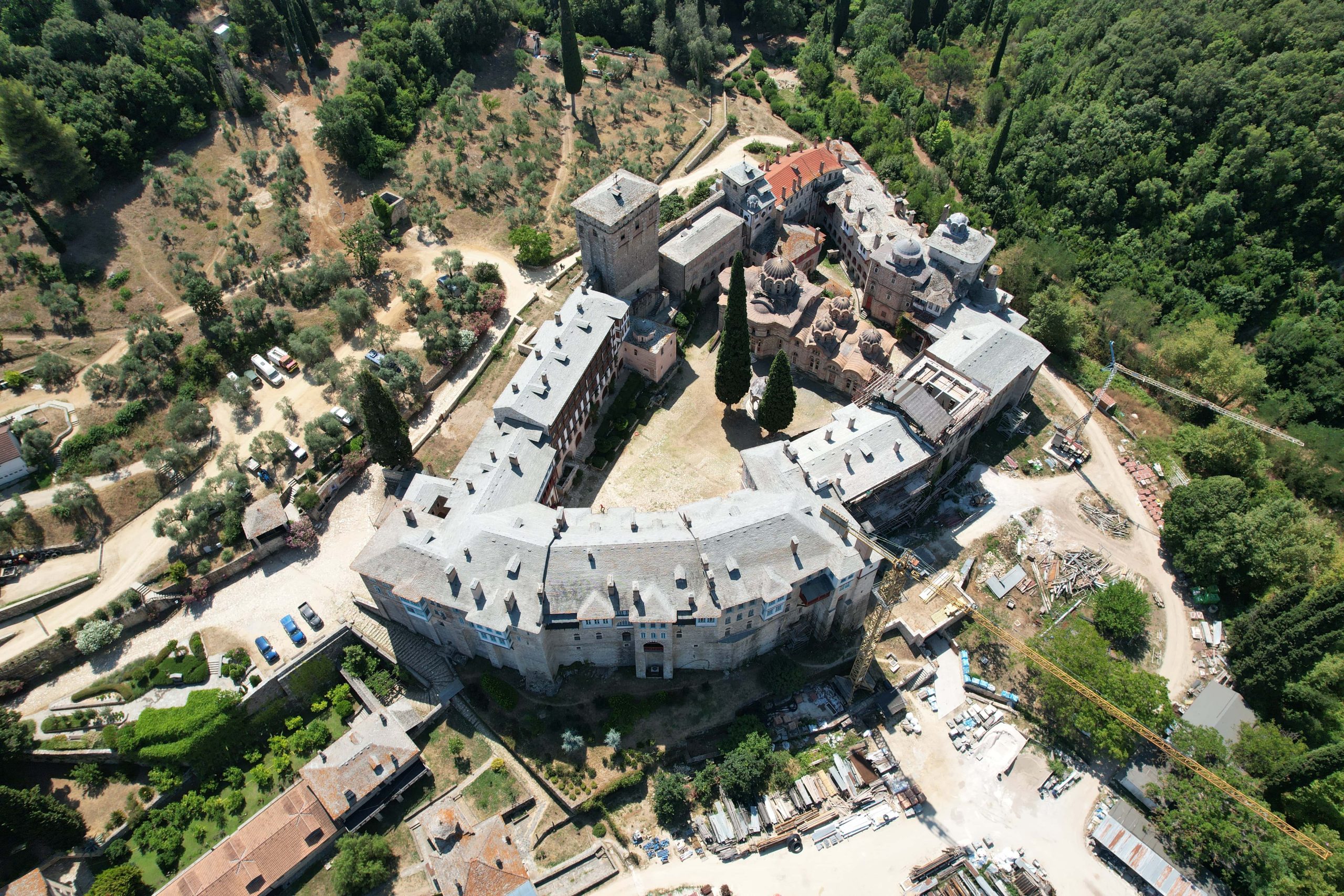
Chilandar Monastery is located on the northeast part of Mount Athos; it is one of the largest and richest in heirlooms monasteries of Mount Athos and has been the main spiritual center of the Serbs from the 12th century onwards.
According to some researchers, the name of the Monastery comes from the Athonite monk George Chilandarios, according to others, from the word “chelandion”, a Byzantine ship.
The history of Chilandar Monastery begins in the 10th century, but after its desolation, it was ceded by emperor Alexios III Angelos in 1198 to the Serbian rulers Stefan Nemanja and his son Rastko, who became monks (Symeon and Savvas respectively) and proceeded with the reconstruction of new buildings. During the 14th century, as well as the ones that followed, the monastery experienced a time of great prosperity and accumulated wealth and heirlooms from imperial and private donations.
Chilandar Monastery is located on the north-eastern part of Mount Athos; it is one of the largest and richest in heirlooms monasteries of Mount Athos and has been the main spiritual center of the Serbs from the 12th century onwards. It ranks fourth in the hierarchy of the Athonite monasteries.
According to some researchers, the name of the Monastery comes from the Athonite monk George Chilandarios, according to others, from the word “chelandion”, a kind of Byzantine ship.
Its katholikon is dedicated to the Presentation of the Virgin Mary and its frescoes are associated with the Macedonian school and painters Eutychios and Michael.
The chapel of the Archangels is situated in the eastern corner of the Monastery precinct, and there are eleven other chapels in the wings. Nine of them are decorated with hagiographies, frescoes from the 13th to the 18th century. The Chilandar monastery has twenty-six cells as dependencies, two of which are in close proximity to the monastery and the rest are located in Karyes. The cell of the Holy Trinity is near the monastery. The historic Kathisma (retreat) of St. Vasilios, a former monydrion, is one of its dependencies.
The history of Chilandar Monastery begins in the 10th century, but after its desolation, it was ceded by emperor Alexios III Angelos in 1198 to the Serbian rulers Stefan Nemanja and his son Rastko, who became monks (Symeon and Savvas respectively) and proceeded with the reconstruction of new buildings. During the 14th century, as well as the ones that followed, the monastery experienced a time of great prosperity and accumulated wealth and heirlooms from imperial and private donations.
In order to better protect Chilandar monastery from marauding raids, King Stefan Uroš I built a large tower in 1262. The Monastery was greatly supported by King Stefan Uroš II Milutin, who built a new katholikon in place of the old one around 1320. At the same time, the Serbian king erected two more towers that served as watchtowers. The katholikon, the refectory and the cemetery chapel were painted in 1321.
During the reign of Emperor Stefan Uroš IV Dušan, the Monastery reached its peak. The Serbian ruler made significant contributions to the Monastery and bequeathed a substantial amount of land in Serbia and Greece.
Towards the end of the 14th century, members of the families of Serbian archons and nobles resorted to Chilandar monastery.
The Ottomans ultimately conquered the Athos peninsula in 1430 and violence and disorder began. So, several monks left the Monastery and went to Serbia. After the final conquest of Serbia, the monastery sought new, powerful patrons and support from other countries.
In the 16th century, monks of the Monastery visited Moscow and requested protection from the Russian Tsar Ivan IV the Terrible, who became a major donor to the Monastery and, in 1556, he provided substantial financial aid and precious gifts.
During the 17th century, the number of Serbian monks declined and they were replaced by Greek and Bulgarian monks and, during the 18th century, after the devastating fire of 1722, the monastery suffered a steady decline. The monastery once again suffered damage in 1891 by an equally destructive fire.
In 1896, it was once again inhabited by Serbian monks, after the visit of the Serbian King Aleksandar Obrenović, who settled all debts of the Monastery.
There are 8 miracle-working icons of the Virgin Mary in the Monastery, the best known of which are Panagia (Virgin Mary) Tricheroussa, Panagia Avramiotissa and the mosaic icon of Panagia Hodegetria. In the sacristy, embroidered vestments and fabrics are preserved, a diptych with 24 miniatures, and various other heirlooms. The monastery library contains 181 Greek and 809 Slavic codices, at least 20.000 printed books, 3.000 of which are Greek, as well as 400 documents in different languages.
On the night of March 3rd, 2004, a fire broke out in the Monastery which quickly took on devastating proportions. The fire burned more than half of the buildings of the Monastery. The monastic brotherhood of Chilandar Monastery, thanks to the substantial financial, logistical and scientific help it received from Serbia, Greece, etc., managed to restore more than 80% of the monastery complex by 2019.
Every five years, a representative of the Monastery assumes the duties of Protepistate of Mount Athos. Archimandrite Methodius is the abbot of Chilandar Monastery.
The Ephorate of Antiquities of Chalkidiki and Mount Athos carried out rescue excavations after the devastating fire of 2004 and managed to preserve portable icons and frescoes (Refectory, Propylon, etc.).
Nikolaos Mertzimekis
References
G. Subotić, Hilandar Monastery, Beograd 1998.
M. Branković, M. Brmbolić, M. Miljković, V. Ristić, Chilandar Monastery, Beograd 2006.
A. Goumatianos – N. Mertzimekis, «Middle Byzantine architectural members from Chilandar Monastery”, Makedonika, vol. 41, Thessaloniki 2016, 119-138.
Address: Konstantinoupoleos 5,
631 00 Polygyros Halkidiki
Phone: +30 23710 22060
Fax: +30 2310 251892
Mount Athos Technical Office
Address: 7 Hippodrome Square, Thessaloniki
Phone: +30 2310 285163
Fax: +30 2310 251892
E-mail: [email protected]
